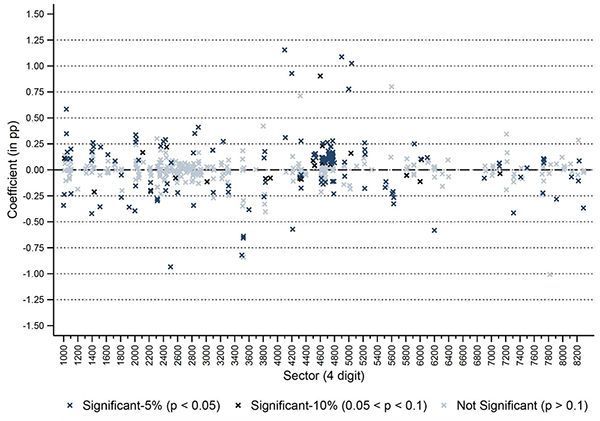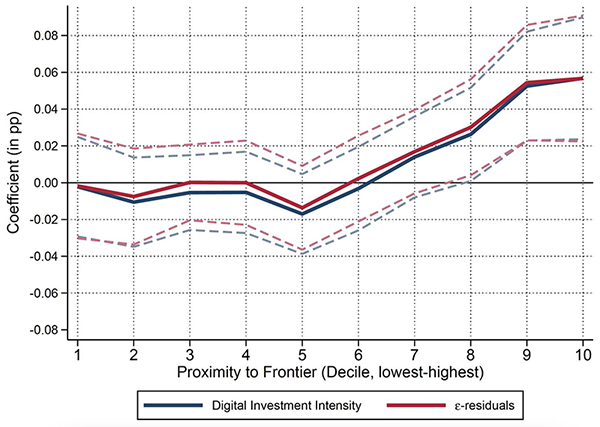Despite the rapid acceleration of digitalisation in recent decades, productivity growth has been slow at the aggregate level across EU countries. This column argues that while digitalisation enhances the productivity of those firms that are already relatively more productive than their competitors, it has only a limited impact for most firms. The authors conclude that investment in digital technologies is more successful when targeted and that policymakers should not consider digitalisation as a ‘one size fits all’ policy to boost productivity.
Digitalisation was expected to deliver strong productivity gains, but despite its rapid acceleration in recent decades, productivity growth has been slow at the aggregate level across EU countries (Vivian et al. 2019). One justification could be that the productivity gains of digitalisation may yet remain to be fully realised because the ‘digital economy’ is still in its installation phase (van Ark 2016). In line with this, if digitalisation is a general purpose technology, then its productivity gains will be characteristically slow to materialise (Brynjolfsson et al. 2021).
These are important and relevant policy issues, given that various policy packages are being implemented with the aim of accelerating digital adoption and thereby boosting productivity, such as the EU’s Digital Single Market and NextGeneration EU programmes. Through its effect on firm-level total factor productivity (TFP) growth and thereby on potential output, inflation, and the natural rate of interest, digitalisation can also have important implications for monetary policy (Anderton et al. 2021).
In a recent paper (Anderton et al. 2023), we argue that while digitalisation accelerates European firms’ TFP growth on average, not all firms become more productive following a sharper investment in digital technologies. The impact of digital investment on a firm’s TFP growth depends not only on the sector of activity, but also on the productivity of the firm relative to its competitors. Digitalisation tends to boost productivity growth mainly for firms who are already relatively more productive than their competitors, while less-productive laggard firms are less able to reap the potential productivity gains from digitalisation.
How does digitalisation – proxied by digital investment - impact firms’ productivity?
We measure digitalisation through two variables, both of which vary at the country-sector-year level. Our first variable – digital investment intensity – is measured as the share of real digital investment (in computer software and databases, information and communication technologies, and research and development) in total real investment. However, increases in the intensity of digital investment can be linked to the decline in the price of digital technology over the past two decades. To take this into account, we construct a second variable of digitalisation by measuring the extent to which the digital investment intensity exceeds, or falls short of, what would be expected from declines in the relative price of digital investment (which we denote as ε-residuals).
Productivity is estimated using revenue-based balance sheet data at the firm level following Gandhi et al. (2020), allowing for the production function to vary at a granular sectoral level. We retrieve these balance sheet data for firms operating in Europe between 2000 and 2019 from Bureau van Dijk’s ORBIS, a large European panel balance sheet dataset. We limit our analysis to firms that provide at least one reporting spell of three or more consecutive years, ending up with 19.3 million observations and nearly 2.4 million unique firms that operate in 13 European countries.
In earlier work, Calvino et al. (2018) bundled the sectors of the economy into digital and non-digital sectors according to the intensity of their usage of digital technology. At first glance, it seems that the average firm in digital sectors is both more productive and manages to improve its productivity faster than the average firm in non-digital sectors. However, this fact masks possible compositional effects and differences in both firm and sectoral characteristics.
We build on the econometric specification by Gal et al. (2019) to estimate the impact of digitalisation on the firms’ productivity growth. We account for channels such as the technological diffusion from frontier firms to the remaining firms in the economy; a productivity catch-up factor based on how far away each firm is from the productivity frontier; compositional effects driven by different firms’ characteristics such as employment size, age, or financial health; and sector-specific characteristics such as market concentration; on top of fixed effects at the country-year and sectoral levels. To account for the technological diffusion channel, we restrict our sample to the 95% least productive firms in each sector, which we label as laggards.
We confirm that digitalisation is on average positively related to the laggard firms’ TFP growth. However, and in line with the ‘productivity paradox’ for aggregate data, we also find that a shift in investment towards digital technology increases the average laggard firm’s TFP growth only mildly: for two otherwise identical firms at a similar point in time and in the same country and sector, a 1 percentage point higher digital investment share, measured with our ε-residuals, will result on average in a 0.02 percentage point higher TFP growth per year. The impact of digitalisation is similar for both laggard and frontier firms, with the latter being much more able to track and implement successfully the productivity innovations from their peers. We also look into the role of intangibles, and find that intangibles can improve frontier firm’s TFP growth either directly or via complementarities with digital technologies, but for laggard firms’ intangibles only boost TFP as a complement to digital investment (see also Corrado et al. 2021 and Brynjolfsson et al. 2021).
Digitalisation is not a ‘one size fits all’ policy to boost productivity
A further inspection of the impact of digitalisation on a firm’s TFP shows that the acceleration of productivity growth stemming from an increase in digital investment is very heterogeneous across the different sectors of economic activity and across firms.
The productivity impacts of sharper investment in digital technologies are heterogeneous across sectors
We find that in roughly 70% of all sectors, the average firm in the sector records no impact of digitalisation on their productivity growth (Figure 1). By contrast, digitalisation is associated with a considerable positive impact on the average firm’s TFP growth in 95 sectors (i.e. 20% of all sectors) of +0.34 percentage points. For the average firm in these sectors, digital technologies are a true gamechanger, allowing it to become considerably more productive over time. However, in roughly 10% of all sectors the impact of digitalisation is negative and amounts to around -0.30 percentage points on average, showing that firms in these sectors incur productivity losses when increasing their digital investment. This does not mean that firms in these sectors should not invest in digital technologies. Rather, these sectors may still be in the installation phase of digital technologies, when their productive use is not yet apparent or easy to implement. Moreover, we do not find that digitalisation has a stronger impact on average on firms’ productivity growth in digital sectors than in non-digital sectors.

[Click to enlarge]
The most productive laggard firms are the ones benefitting the most from digitalisation
We also investigate whether digitalisation benefits all laggard firms similarly, or whether only the most-productive laggards are able to reap the benefits. Figure 2 shows the marginal impact of a 1 percentage point higher digital investment share on the average firm’s TFP growth, allowing for this impact to differ according to distance from the sector’s productivity frontier – that is, we show the marginal impact of digitalisation by decile of the firm’s proximity to the productivity frontier. The results reveal that the 70% least-productive laggard firms do not benefit on average from digitalisation. Instead, the benefits of investing in digital technologies are concentrated among the 30% most-productive laggards. In other words, only the most-productive laggards are effectively able to productively use digital technologies to accelerate their TFP growth and thereby become more productive over time. The impact of digitalisation on the productivity growth of highly productive laggards is between two to three times larger than the impact that we measured for the average laggard firm in our benchmark results mentioned above. This suggests that highly productive laggards are more capable of embedding digital investments in their processes and productively using digital technologies than their less-productive peers.

[Click to enlarge]
What about the most productive frontier firms?
While more productive laggards benefit the most from digital technologies, this does not mean that a boost in digital investment alone is sufficient to turn top laggard firms into productivity leaders in their sectors. Instead, highly productive laggards need to search for a major innovation in order to jump the productivity ladder and become a frontier firm. In fact, we find that the average frontier firm benefits from digital investment similarly to the average laggard firm, but is also much more able to track and implement successfully the productivity innovations from its peers, leading to a faster transmission across firms from any innovation related to digital technologies. Taken together, these results highlight that digitalisation does not seem to enhance firm churning into (and out of) the productivity frontier.
Conclusions
Overall, our results suggest that digitalisation does not tick all the productivity boxes. Digitalisation seems to be a productivity gamechanger only for some firms, but it is more like a productivity sideshow for other firms that invest in digital technologies but are not able to adequately reap the productivity gains. Nevertheless, digitalisation is like other general purpose technology in the sense that it takes time to deliver on its potential productivity gains. If adopted successfully, it could become a gamechanger in the future, and particularly so given the rapid and wide-ranging rise in the use of digital technologies during the COVID-19 pandemic (Amankwah-Amoah et al. 2021, Schierholz et al. 2021). Finally, given that digitalisation has heterogeneous impacts on productivity, it should not be viewed as a ‘one size fits all’ policy to boost productivity across firms. Instead, our results suggest that policy packages accelerating firms’ adoption of digital technologies are more likely to be successful in cases where these measures are targeted towards relatively more productive firms, and towards sectors or specific innovations that are likely to observe large benefits from digitalisation that can improve the potential output of the economy, independently of the existing installation costs in the adoption of these technologies.
This article first appeared on VoxEU on April 20, 2023. Reproduced with permission.




